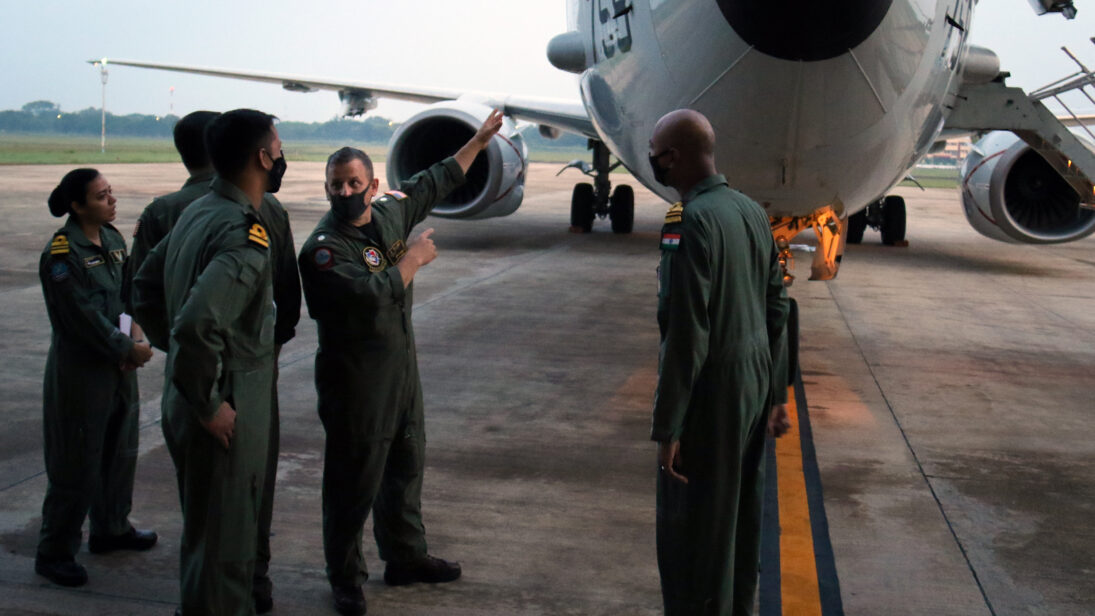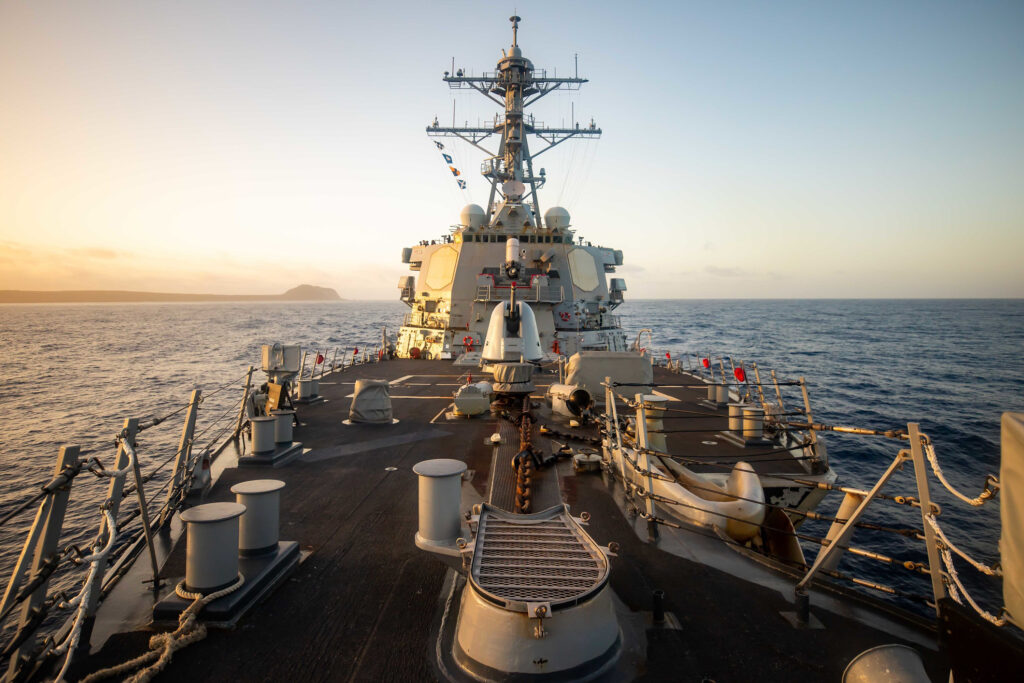
Logistics matter. Ask any casual observer to discuss the effectiveness of the Russian invasion of Ukraine and they will point out that Russia’s failure to adequately plan to supply food, water, fuel, and ammunition has drastically decreased the combat capability of the numerically superior Russian forces. Photos and videos of fearless Ukrainian farmers pulling ML-TB tracked vehicles and other Russian military hardware, apparently broken down or out of fuel provide a clear and present example of how a lack of logistics support can derail a military operation. In the case of the Ukrainian invasion, Russia is struggling to provide support across an adjacent land border. If we think how a similar crisis might unfold in the maritime theater of the Indo-Pacific—where the distances involved are vast and shipping resources scarcer—how would the United States, and other countries that support the Quad—a security grouping comprising US, India, Japan, and Australia—fare? According to Brookings, China’s Indian Ocean Region (IOR) expansion will eventually allow them to “meaningfully hold at risk United States or Indian assets in the event of a wider conflict.” I propose the countries that make up the Quad should use the existing approved agreements—including strengthening their relationship through maritime logistics and ship repair—before China completes its planned expansion into the IOR.
The United States and India signed the Logistics Exchange Memorandum of Agreement (LEMOA) on August 29, 2016, at a ceremony in Washington, DC. The agreement allows India and the United States to access military facilities for fueling and logistics during “joint military exercises, training, port calls, humanitarian missions and other military activities that both sides mutually agree to undertake.” By creating a ledger that is balanced at the end of each year, the two militaries can more easily exchange goods and fuel at sea. The most visible usage of this agreement is underway replenishments (UNREP) during joint exercises, such as MALABAR. During UNREP, a combatant ship receives stores and fuel while at sea from a logistics ship, allowing the combatant to stay at sea for longer periods of time. After signing LEMOA with the United States, India signed similar bilateral logistics agreements with Japan and Australia.
I propose the countries that make up the Quad should use the existing approved agreements—including strengthening their relationship through maritime logistics and ship repair—before China completes its planned expansion into the IOR.
Though the LEMOA seems non-controversial, India had serious reservations about signing the agreement because of its historical non-alignment policy. While LEMOA does not provide basing rights for United States forces, it does provide reciprocal access to conduct repairs. The United States and India should look for ways to take advantage of these “access rights” on a regular basis to expand each navy’s capacity. At the most recent 2+2 dialogue, India and the United States discussed the desire to use Indian shipyards to complete mid-deployment repairs to United States Maritime Sealift Command (MSC) ships. The Quad countries should build on these bilateral agreements and negotiate a multilateral logistics agreement. A first iteration of a multilateral agreement could include provisions for reciprocal access to fuel, food, other goods, and access to ports for repairs during joint military exercises. This first Quad multilateral agreement could be the basis for further Quad military collaboration in the Indo-Pacific, including efforts to detect and classify surface traffic or anti-submarine patrols. However, China might negatively perceive a multilateral logistics agreement as the foundation of a military alliance, akin to a westward expansion of NATO. Despite this potential perception, the benefits of continued cooperation far outweigh the potential costs of closer ties amongst Quad nations. A multilateral logistics agreement could contribute to building a “free and open Indo-Pacific” as laid out by United States Secretary of State Blinken. One of the less explored areas of the access rights afforded by LEMOA is expeditionary ship repair.
With basing support already established in the Indo-Pacific, the United States has access to existing ports that are used for repairs, namely in Singapore and Japan. With China placing more anti-surface weapons to hold surface vessels at risk inside the first island chain, while continuing to expand their influence westward into the Indian Ocean, the United States must seek other non-traditional repair options. As India looks to build out Port Blair in the Andaman and Nicobar Islands (ANI), this partnership could be advantageous both to India and the United States. Ashutosh S. Patki has written about the strategic importance of the ANI. A joint-venture to improve military repair facilities in the ANI would send a strong signal to China about the strength of the United States and Indian relationship given India’s historic non-alignment, even without granting basing rights to the United States. Establishment of a far east base in the ANI is also part of India’s “4-pronged strategy,”1 which includes building new ports, establishing strategic presence outside of mainland India, further promoting defense cooperation with other countries—including the United States—and aggressively modernizing the Indian Navy. Access to future facilities in India, whether ANI or on the east coast of India, could also come with reciprocal negotiated access to United States ports in the Pacific.

There are other possible repair locations within India that the United States could use, including naval ports in Mumbai (Mazgaon Dockyard Limited), Kochi (Cochin Shipyard Limited), Goa (Goa Shipyard Limited), and Visakhapatnam (Hindustan Shipyard Limited). Former U.S. National Security Council official Peter Lavoy has stated “the evolving relationship between the United States and India…presents a ‘tremendous opportunity’” that has potential to expand beyond current military cooperation, including maritime domain awareness activities.2 Given the United States’ desire for India to distance itself from Russia and the sale of Russian-made arms, an agreement that begins to bring the United States and Indian Navy together to strengthen their bonds may increase goodwill and deepen the military relationship.
Given the build-up and capability of China in the Indian Ocean, continued United States and Indian presence in the Indian Ocean is unlikely to diminish in the future. In a maritime conflict in the IOR, the United States Navy may incur ship damage and not have the time or inclination to complete a heavy lift back to a traditional United States Navy repair facility. Support capabilities at Apra Harbor, Guam, have also dwindled in the last several decades. With Guam largely out of commission for United States ship repair, it is even more important for the United States to increase access to other places in the Indo-Pacific. By allowing U.S. and other Quad countries access to ship repair facilities in the IOR, India would benefit from more sustained presence from like-minded countries in an unfriendly maritime domain.
The ability to repair ships within the IOR would likely lead to more ships remaining in the critically important region where they will be needed to deter China, protect international trade, and be present for other maritime activities to enable a “free and open Indo-Pacific.”
As indicated in the United States Navy’s comments in the GAO report, Naval Sea Systems Command (NAVSEA) is the designated lead for expeditionary battle damage repair, with coordination partners in other parts of the Navy organization. I recommend Commander Task Force 73 (CTF-73) serve as lead for the expeditionary battle damage repair process in the Indo-Pacific. To prepare for the administration and planning for exigent circumstances, the United States must plan and execute repairs of a Navy ship in non-traditional ports in the Indo-Pacific. Using LEMOA and mutually agreed upon Indian ports, CTF-73 should propose a small, planned work package to complete in Port Blair. The first package should consist of routine work that any competent ship fitter can complete, such as a sea water pump replacement, or a condenser tube replacement. The United States Navy maintenance team will coordinate contracting, work-planning, supervision, and acceptance of the repairs, while the other aspects of a port visit will be completed using procedures already in place. As several of these small packages are completed and the relationship matures, the United States can introduce more complex hull, mechanical, and electrical repairs. The first regular joint United States-Indian underway replenishments started during MALABAR exercises. Likewise, the first ship repair using LEMOA in an Indian shipyard should also be completed during the in-port phase of MALABAR. The crew will complete other aspects of training, while the maintenance team flexes a critical skill. The ability to schedule, plan, and conduct maintenance in non-traditional United States ports will be a crucial first step to understanding the process required to complete future expeditionary repairs. The ability to repair ships within the IOR would likely lead to more ships remaining in the critically important region where they will be needed to deter China, protect international trade, and be present for other maritime activities to enable a “free and open Indo-Pacific.”
The opinions expressed here are those of the author and do not reflect those of the United States Navy or Department of Defense.
***
Image 1: U.S. Indo-Pacific Command via Flickr
Image 2: U.S. Indo-Pacific Command via Flickr


